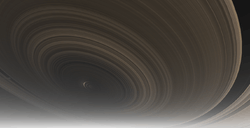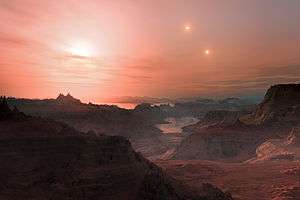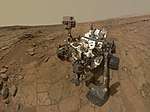RR Caeli
RR Caeli is a double star in the constellation Caelum. It is approximately 66 light years from Earth.[2] It was first noted to be a high-proper motion star in 1955 by Jacob Luyten, and given the name LFT 349. Discovered to be an eclipsing binary in 1979, it has a baseline magnitude of 14.36, dimming markedly every 7.2 hours for an interval of around 10 minutes, due to the total eclipse of the brighter star by the fainter one. Its variability in brightness led to its being given the variable star designation RR Caeli in 1984.[3] This star system consists of a red dwarf of spectral type M6 and a white dwarf that orbit each other every seven hours; the former is 18% as massive as the Sun, while the latter has 44% of the Sun's mass.[3] The red dwarf is tidally locked with the white dwarf, meaning it displays the same side to the heavier star.[4] The system is also a post-common-envelope binary, and the red dwarf star is transferring material onto the white dwarf. In approximately 9–20 billion years, RR Caeli will likely become a cataclysmic variable star due to the period's gradual shortening, leading to increasing rates of transfer of hydrogen to the surface of the white dwarf.[1]
| Observation data Epoch J2000 Equinox J2000 | |
|---|---|
| Constellation | Caelum |
| Right ascension | 04h 21m 05.563s |
| Declination | −48° 39′ 07.02″ |
| Apparent magnitude (V) | 14.40 |
| Characteristics | |
| Spectral type | DA7.8 + M6V |
| U−B color index | −0.42 |
| B−V color index | 0.52 |
| Astrometry | |
| Proper motion (μ) | RA: 17.9 mas/yr Dec.: −538.3 mas/yr |
| Parallax (π) | 49.68 ± 1.34 mas |
| Distance | 66 ± 2 ly (20.1 ± 0.5 pc) |
| Details[1] | |
| White dwarf | |
| Mass | 0.440 ± 0.023 M☉ |
| Radius | (0.015–0.016) ± 0.0004 R☉ |
| Luminosity (bolometric) | 0.0007 ± 0.00015[note 1] L☉ |
| Surface gravity (log g) | (7.67–7.72) ± 0.06 cgs |
| Temperature | 7,540 ± 175 K |
| Red dwarf | |
| Mass | (0.182–0.183) ± 0.012 M☉ |
| Radius | (0.203–0.215) ± 0.015 R☉ |
| Luminosity (bolometric) | 0.0038 ± 0.0013[note 1] L☉ |
| Surface gravity (log g) | (5.04–5.09) ± 0.04 cgs |
| Temperature | 3,100 ± 113 K |
| Other designations | |
RR Caeli, LFT 349, WD 0419-487, GJ 2034 AB | |
| Database references | |
| SIMBAD | data |
| Exoplanet Archive | data |
| ARICNS | data |
| Extrasolar Planets Encyclopaedia | data |
Planetary system
In 2012, analysis of slight variations in the observed light curve of the system showed that there was almost certainly a giant planet about four times as massive as Jupiter orbiting the pair of stars with a period of 11.9 years, and that there was evidence for a second possible substellar body further out as well.[5] More observations of the light curve are likely to help confirm the presence of one or both planets.[5]
| Companion (in order from star) |
Mass | Semimajor axis (AU) |
Orbital period (years) |
Eccentricity | Inclination | Radius |
|---|---|---|---|---|---|---|
| b | ≥4.2 ± 0.4 MJ | ~5.3 ± 0.6 | 11.9 ± 0.1 | 0 | >17.6° | — |
Notes
- From , where is the luminosity, is the radius, is the effective surface temperature and is the Stefan–Boltzmann constant.
References
- Maxted, P. F. L.; O'Donoghue, D.; Morales-Rueda, L.; Napiwotzki, R.; Smalley, B. (2007). "The mass and radius of the M-dwarf in the short-period eclipsing binary RR Caeli". Monthly Notices of the Royal Astronomical Society. 376 (2): 919–928. arXiv:astro-ph/0702005. Bibcode:2007MNRAS.376..919M. doi:10.1111/j.1365-2966.2007.11564.x.
- "V* RR Caeli – Eclipsing binary of Algol type (detached)". SIMBAD. Retrieved 18 February 2013.
- Bruch, A.; Diaz, M. P. (1998). "The Eclipsing Precataclysmic Binary RR Caeli". The Astronomical Journal. 116 (2): 908–916. Bibcode:1998AJ....116..908B. doi:10.1086/300471.
- Ribeiro, T.; Baptista, R.; Kafka, S.; Dufour, P.; Gianninas, A.; Fontaine, G. (2013). "Accretion and activity on the post-common-envelope binary RR Caeli". Astronomy & Astrophysics. 556A: A34. arXiv:1307.5921. Bibcode:2013A&A...556A..34R. doi:10.1051/0004-6361/201220340.
- Qian, S. B.; Liu, L.; Zhu, L. Y.; Dai, Z. B.; Fernández Lajús, E.; Baume, G. L. (2012). "A circumbinary planet in orbit around the short-period white dwarf eclipsing binary RR Cae". Monthly Notices of the Royal Astronomical Society: Letters. 422: L24. arXiv:1201.4205. Bibcode:2012MNRAS.422L..24Q. doi:10.1111/j.1745-3933.2012.01228.x.


